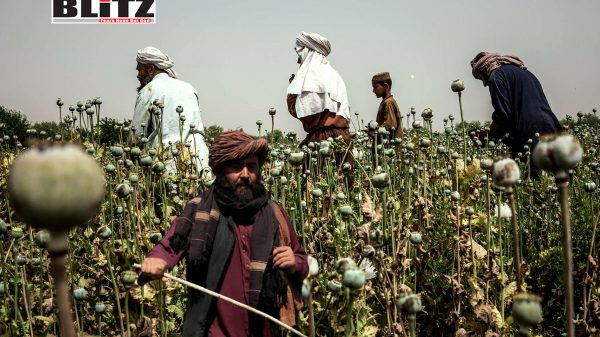Afghanistan’s opium decline masks a dangerous rise in synthetic drug production
- Update Time : Monday, November 10, 2025

Afghanistan, long synonymous with the world’s largest opium supply, is undergoing a historic transformation-one driven less by economic evolution and more by drastic political decrees. According to a new report from the United Nations Office on Drugs and Crime (UNODC), opium poppy cultivation in the country dropped by 20% in 2025, continuing the sharp decline that followed the Taliban’s 2022 nationwide poppy ban. Yet the news, while seemingly positive on the surface, comes with a dangerous twist: as opium withers, synthetic drug production is rapidly expanding, threatening to fuel a new and potentially more destructive phase of the regional narcotics trade.
The latest UNODC estimate places Afghanistan’s 2025 poppy cultivation at 10,200 hectares, down from 12,800 hectares in 2024. The reduction is dramatic when viewed against the country’s pre-ban levels, which exceeded 232,000 hectares. Opium production has fallen even more sharply-by 32% to 296 tons-as the combination of eradication policies, crop shifts, and Taliban enforcement measures reshaped the economic landscape in rural areas.
But while poppy fields have shrunk, the livelihoods connected to them have suffered accordingly. Afghan farmers’ income generated from opium sales has nearly halved, dropping to $134 million. For a country where rural communities depend on agriculture for survival and employment options remain scarce, the decline in illicit crop profits is not simply a matter of economics; it is a matter of survival.
For decades, Afghanistan’s poppy cultivation was driven by a mix of necessity, geography, and weak governance. The crop thrived in the arid climate and provided farmers with predictable profit margins unmatched by legal alternatives. In enforcing the 2022 ban, the Taliban sought-in part-to gain international legitimacy by demonstrating control over narcotics production. But the ban coincided with a period of mounting hardships.
Many farmers have attempted to shift to legal crops, growing cereals like wheat and barley, or cultivating vegetables and fruits. Yet climate conditions have been brutal. Drought and poor rainfall have left more than 40% of farmland barren, severely limiting viable alternatives. These environmental challenges mean that even farmers willing to comply with the ban face low yields, unstable markets, and dwindling incomes.
The situation has been further strained by the return of approximately 4 million Afghans from Pakistan and Iran, many of whom were deported or compelled to leave due to increasing pressure from neighboring countries. Their arrival has intensified competition for land, food, and employment. Aid agencies warn that without major international intervention, some communities may see no choice but to return to poppy cultivation, despite the risks of punishment.
Observers note that the Taliban has demonstrated a level of enforcement capacity unprecedented in past Afghan governments. Their destruction of poppy fields has been widespread, and local commanders-often former insurgents familiar with the terrain-have shown an ability to suppress cultivation effectively.
However, enforcement has not been identical across all regions. Some areas with strong Taliban political or tribal connections have reportedly seen more lenient oversight, while others have faced harsh crackdowns. The economic pressure of the ban is testing the Taliban’s relationship with rural communities, who formed the backbone of their support during the insurgency.
This delicate balance raises questions about the sustainability of the poppy ban. If economic desperation worsens, and the international community fails to deliver meaningful support for alternative livelihoods, the ban could collapse under its own political cost.
While opium production shrinks, an equally troubling development has emerged: a surge in synthetic drug production, particularly methamphetamine. According to UNODC data, seizures of meth in and around Afghanistan rose 50% by the end of 2024, signaling both expanding production and expanding trafficking networks.
This shift is partly driven by economics. Methamphetamine production requires no arable land, relies on chemical precursors easier to obtain than previously believed, and provides criminal networks with higher profit margins and easier concealment. Unlike opium-which is bulky, requires cultivation, and depends on harvest seasons-meth labs can operate year-round in remote areas.
The transition from plant-based narcotics to synthetics is also aligned with broader global criminal trends. Across Asia and Europe, demand for synthetic stimulants is rising, while law enforcement agencies struggle to detect and dismantle the more mobile, dispersed production methods used by meth producers.
UNODC regional representative Oliver Stolpe emphasized the implications clearly: “Afghanistan’s path to overcoming illicit crop cultivation requires coordinated, long-term investments. Empowering Afghan farmers through alternative livelihoods and addressing both supply and demand are key.” His warning underscores a reality that policymakers can no longer ignore-Afghanistan’s drug economy is not disappearing; it is transforming.
The ramifications are far-reaching. European and Asian drug markets, historically flooded with Afghan heroin, may soon experience greater penetration of Afghan-linked meth networks. Synthetic drugs also carry higher risks for users, contributing to addiction, mental health crises, and overdose deaths.
For Afghanistan’s neighbors, the rise in synthetic drugs poses a mounting security threat, as trafficking routes become more flexible and criminal groups more technologically sophisticated. Countries like Iran, Pakistan, Tajikistan, and Uzbekistan, already burdened by heroin flows, may face a second wave of narcotics challenges that are harder to track and contain.
Ultimately, Afghanistan’s declining opium cultivation should not be misread as a triumph. Without urgent international investment-particularly in agriculture, water systems, rural employment, and alternative market access-the economic void left by opium will deepen. Meanwhile, the synthetic drug boom risks creating a new, even more entrenched criminal economy.
Afghanistan now stands at a crossroads. One path leads to sustainable development and a gradual reduction in illicit economies. The other leads to an escalation of synthetic drug proliferation, destabilizing the region and undermining global drug control efforts.
International policymakers must recognize that the issue extends beyond Afghanistan’s borders. Whether the world responds with meaningful assistance or allows the current situation to deteriorate will determine not only Afghanistan’s future, but the future of regional and global drug markets for years to come.










